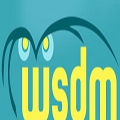In this paper we study the implications for conference program committees of using single-blind reviewing, in which committee members are aware of the names and affiliations of paper authors, versus double-blind reviewing, in which this information is not visible to committee members. WSDM 2017, the 10th ACM International ACM Conference on Web Search and Data Mining, performed a controlled experiment in which each paper was reviewed by four committee members. Two of these four reviewers were chosen from a pool of committee members who had access to author information; the other two were chosen from a disjoint pool who did not have access to this information. This information asymmetry persisted through the process of bidding for papers, reviewing papers, and entering scores. Reviewers in the single-blind condition typically bid for 22% fewer papers, and preferentially bid for papers from top institutions. Once papers were allocated to reviewers, single-blind reviewers were significantly more likely than their double-blind counterparts to recommend for acceptance papers from famous authors and top institutions. The estimated odds multipliers are 1.63 for famous authors and 1.58 and 2.10 for top universities and companies respectively, so the result is tangible. For female authors, the associated odds multiplier of 0.78 is not statistically significant in our study. However, a meta-analysis places this value in line with that of other experiments, and in the context of this larger aggregate the gender effect is also statistically significant.
翻译:在这份文件中,我们研究了使用单盲审查对会议方案委员会的影响,即委员会成员了解纸质作者的姓名和从属关系,而使用双盲审查,使委员会成员无法看到这些信息。WSDM 2017,第十届ACM国际ACM网上搜索和数据采矿会议进行了一项受控实验,每份文件均由4名委员会成员审查。这4名审查者中有2名是从获得作者资料的委员会成员中挑选出来的;另外2名来自一个不连贯的人才库,没有获得这一资料;这种信息不对称通过文件招标、审查论文和进入分数的过程持续存在。在单盲情况下的审查者通常要少出22%的论文,而最高级机构的论文则要优先出价。一旦向审查者分配了文件,单盲审查者比其双盲同行建议接受著名作者和最高机构的文件的可能性要大得多。估计的几率分别为著名作者1.63人和顶级大学和公司1.58和2.10,因此,这一结果是显而易见的。对于女性作者来说,在这种单一条件下的审查者,通常要少出22%的文件,而在最高机构里,这一统计学系中,这一数值的比重的比重的数值是其他的数值。



